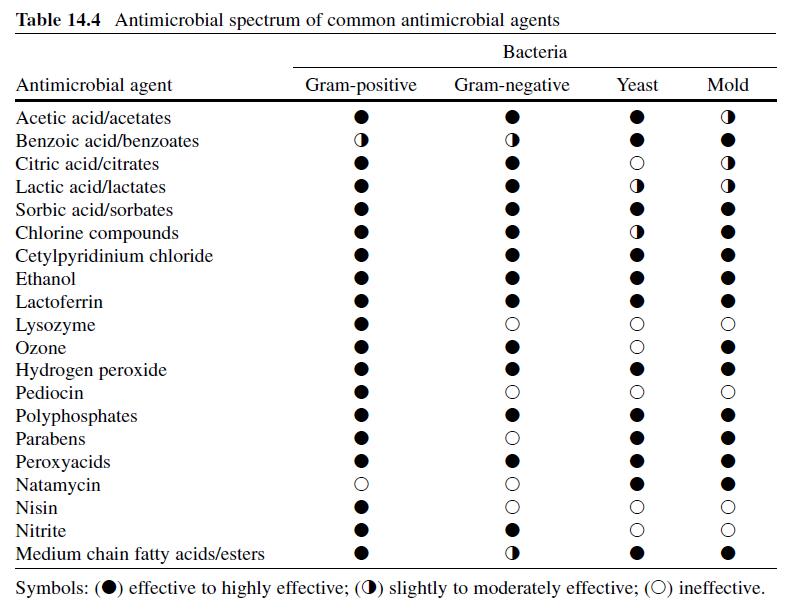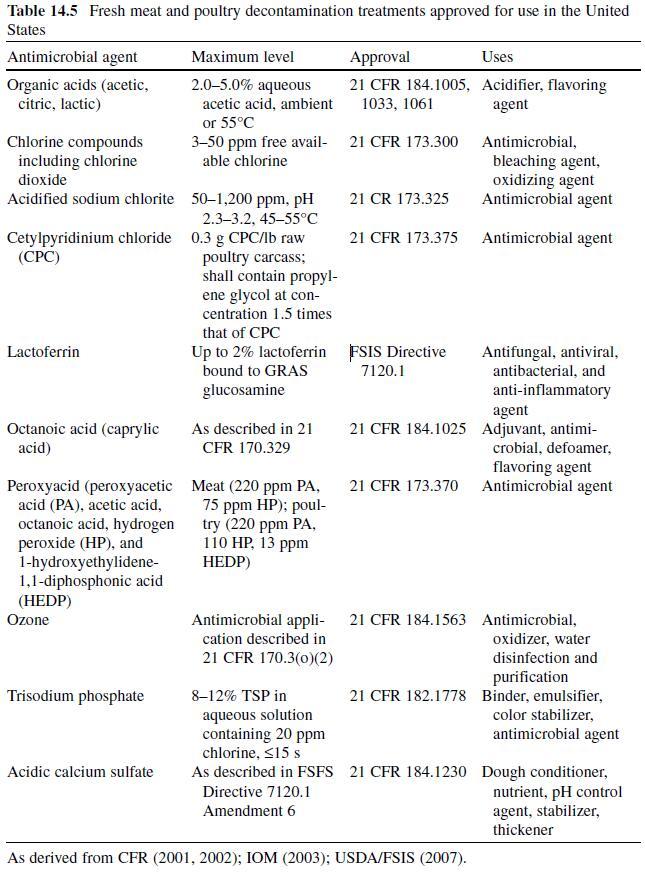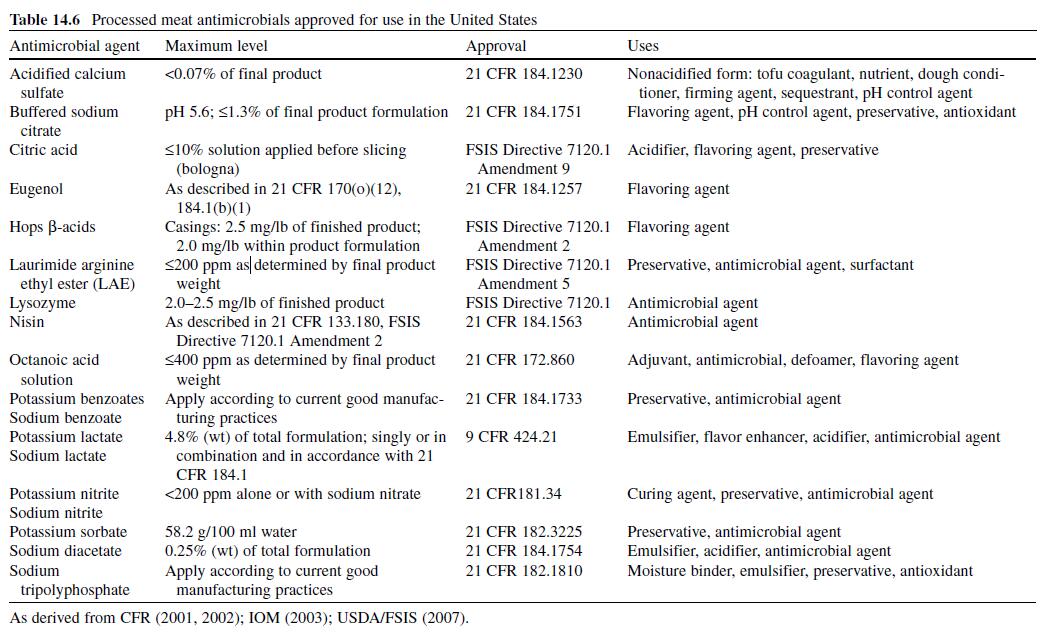Medium- and Long-Chain Fatty Acids: Application in Processing Meat Products
Mar 16,2022
Characteristics and Properties
Medium and long-chain-length fatty acids have exhibited the ability to inhibit/inactivate
foodborne pathogens, but are more commonly used as adjuvants and wetting agents or
as components of hygiene and sanitation programs (Burnett et al., 2007 ; IOM, 2003;
Kabara & Marshall, 2005 ; Mbandi, Brywig, & Shelef, 2004) . Chemically, mediumchain
fatty acids are lipids with carbon chains of eight to fourteen carbons in length
(Sofos et al., 1998) and include caprylic or octanoic (8:0), capric (10:0), and lauric
(12:0) acid; long-chain fatty acids (≥16 carbon chain length) include palmitic (16:0),
steric (18:0), oleic (18:1), linoleic (18:2), and linolenic (18:3) acid. Both, the degree of
saturation and carbon chain length influence antimicrobial activity and spectrum of
microorganisms affected by these acids (Kabara, 1993 ; Nieman, 1954 ; Sofos et al.,
1998) . In general, those with chains of 14 carbons or less, branched-chain fatty acids,
those which contain hydroxyl groups, and saturated fatty acids are less effective as
antimicrobials (Conley & Kabara, 1973 ; Nieman, 1954).
Fatty acids are esterified by replacing the hydrogen atom of the acid group with
an alcohol (e.g., ethanol) or a sugar group (e.g., glycerol). Conley and Kabara
(1973) found that antimicrobial activity is lost when fatty acids are esterified with
hydrophobic compounds. In contrast, the addition of hydrophilic compounds compliments
the hydrophobic nature of fatty acids, and subsequent antimicrobial activity
may be intensified. The same is also true for short-chain fatty acids (Davidson,
2001) . In general, esterified fatty acids convey more intense flavors/aromas and
provide more potent antimicrobial activity against a broader spectrum of microorganisms
than their unesterified counterparts (Sofos et al., 1998).


Collectively, medium- and long-chain fatty acids do not respond uniformly to environmental conditions or food properties, nor do they act on similar types of microorganisms. However, antimicrobial activity is generally optimized at pH values of 4.6 or less and involves cell membrane interactions which result in impaired function and leakage or the intracellular dissociation of fatty acid molecules (Burnett et al., 2007 ; Monk, Beuchat, & Hathcox, 1996 ; Oh & Marshall, 1992) . Gram-positive bacteria, yeasts, and molds are generally fatty acid-sensitive (Table 14.4 ) (Nieman, 1954) . Gram-negative bacteria are not usually inhibited by fatty acids of more than eight carbons in length (Conley & Kabara, 1973) , although previous exposure to other types of stress may increase the likelihood of inhibition by medium- and long-chain fatty acids (Sofos et al., 1998) . The antimicrobial activity of fatty acids may be reduced in the presence of serum albumin and other protein compounds, starches, cholesterol, lecithin, and calcium or magnesium ions (Sofos et al., 1998) . Fatty acids are also less likely to be homogenously distributed within products which contain lipids (Sofos et al., 1998) . Wang and Johnson (1997) described the limitations of coconut-derived monoglycerides in regard to lack of distribution in lipid phases of food products, and found that ethanol, sodium citrate (0.1%), propylene glycol, (0.1%) and glycine (0.1–0.2%) could also be used as carriers of fatty acids, without antagonizing antimicrobial activity.
Applications
Octanoic or caprylic acid (CH 3 -[CH 2 ] 6 -COOH; log P oct , 2.845) has GRAS approval and may be used to decontaminate the surfaces of beef carcasses and as an antimicrobial on RTE meat and poultry products ( Tables 14.5 and 14.6 ) (Leo et al., 1971) . The compound is characterized by a moderately sweet odor/taste, reminiscent of butter or cheese and, at neutral pH values, is more effective as an antimicrobial than other acids (Doores, 2003) . Lauramide arginine ethyl ester (LAE) dissolved in propylene glycol may be applied to the surfaces (200 ppm) of fresh meat and poultry cuts, and to nonstandardized RTE meat and poultry products (Table 14.6 ). When the antilisterial activities of several medium- and long-chain fatty acids (50–700 μg/ ml of conjugated lauric acid, monolaurin, capric, lauric, myristic, palmitic, stearic, oleic, linoleic, or linolenic acid) were compared, lauric acid > monolaurin > capric acid most effectively inhibited the growth of L. monocytogenes in a broth system (Mbandi et al., 2004) . The antilisterial activity of lauric acid, monolaurin, and capric acid was greater when used in combination compared to individual applications, although no combination (≤500 μg/ml) adequately inhibited growth of L. monocytogenes in emulsified beef tissue or in frankfurters during storage (5°C, 21 days) (Mbandi et al., 2004) . Surface treatments of lauric arginate (4 or 8 ml of 5.0% or 2 ml of 10.0% solution placed into shrink wrap bags just before vacuum-packaging) substantially reduced L. monocytogenes counts on “table brown” hams after 24 h (4°C), and inhibited growth during extended storage (60 days) (Luchansky et al., 2005) . Others have also reported the success of monolaurin treatments in the inhibition of L. monocytogenes associated with processed meat products (Doyle, 1999) . The antimicrobial activity of monolaurin is temperature- and pH-dependent, and increases as both parameters are lowered (Doyle, 1999 ; Monk et al., 1996 ; Oh & Marshall, 1992) . When placed in pouches containing whole muscle oven-roasted turkey breast, oil-browned turkey breast, cured ham, roast beef, and comminuted roast beef just before vacuum-packaging or shrink-wrapping (93.3°C, 2 s), octanoic acid (1%; adjusted to pH 2 or 4 with phosphoric or citric acid, respectively) reduced L. monocytogenes counts (5 log CFU/sample reduced by 0.85–2.89 log CFU/sample) after 24 h at 5°C (Burnett et al., 2007) . Octanoic acid was more effective at pH values of 4 compared to 2 and greater microbial reductions were observed after longer heat-shrink exposures (Burnett et al., 2007) .

- Related articles
- Related Qustion
- How can fatty acids be synthesized? Jul 24, 2024
Synthesis of fatty acids involves adding two-carbon units to a growing chain.
Acids are generally more effective against a broader range of microorganisms when used in combination with additional antimicrobial agents, including other organic acids (Lueck, 1980 ; Malicki, Jarmoluk, & Bruzewicz, 2004) .....
Mar 16,2022Food AdditivesStanozolol can be administered orally or intramuscularly. Some of its therapeutic uses include the treatment of aplastic anemia and hereditary angioedema.....
Mar 16,2022APIFattyAcid
106168-45-0You may like





